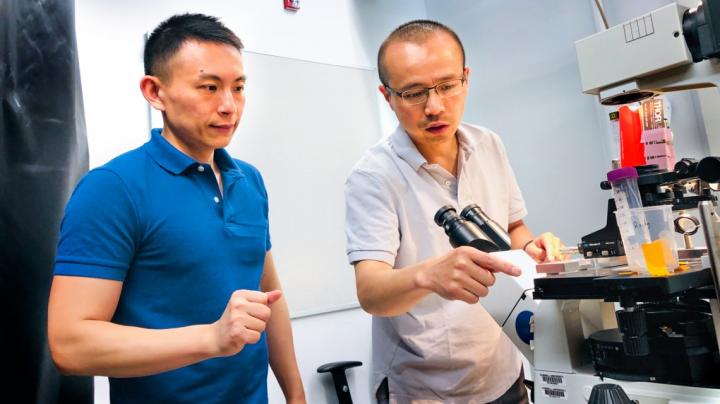This competition-enabled, superresolution imaging technique is applicable to a wide range of catalytic reactions. It is based on the incorporation of competition into a single-molecule fluorescence-detection scheme. The competition (a nonfluorescent reaction) suppresses the fluorescent reaction, allowing the fluorescent reaction to be measured and mapped. This process, in turn, provides information about the nonfluorescent reaction. The method is named COMPetition Enabled Imaging Technique with Super-Resolution, or COMPEITS.
 Xianwen Mao (left) and Peng Chen, the Peter J.W. Debye Professor of Chemistry, are pictured in the microscope room in Olin Research Laboratory. Courtesy of Rocky Ye, Cornell University.
The researchers demonstrated COMPEITS by investigating a photoelectrocatalytic reaction that is important for water decontamination on single photocatalyst particles. They imaged the oxidation of hydroquinone, a micropollutant found in water, on bismuth vanadate catalyst particles, and discovered previously unknown behaviors of catalysts that helped render hydroquinone nontoxic.
Xianwen Mao (left) and Peng Chen, the Peter J.W. Debye Professor of Chemistry, are pictured in the microscope room in Olin Research Laboratory. Courtesy of Rocky Ye, Cornell University.
The researchers demonstrated COMPEITS by investigating a photoelectrocatalytic reaction that is important for water decontamination on single photocatalyst particles. They imaged the oxidation of hydroquinone, a micropollutant found in water, on bismuth vanadate catalyst particles, and discovered previously unknown behaviors of catalysts that helped render hydroquinone nontoxic.
“This highly generalizable technique can be broadly applied to image various classes of nonfluorescent systems, such as unlabeled proteins, neurotransmitters, and chemical warfare agents,” professor Peng Chen said. “Therefore, we expect COMPEITS to be a breakthrough technology with profound impacts on many fields including energy science, cell biology, neuroscience, and nanotechnology.”
The research was published in Nature Chemistry (https://doi.org/10.1038/s41557-019-0288-8).

